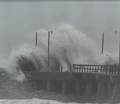





HURRICANE "SCARLET" HITS GEORGIA COASTLINE:
Research Group: K. Nam, J. Guan and M. M. Aral
Well..., not yet, but if New Orleans has their "KATRINA," Texas has their "RITA" and Florida has their "WILMA" we may have our "SCARLET" in Georgia some day.
In this web site (below) you will find out our simulation results for a catastrophic hurricane, similar to "Hurricane Katrina," "Hurricane Rita" or "Hurricane Wilma" hitting eastern Georgia coastline. We hope this activity will stay in the domain of simulations and academic exercise.
First we show an estimate of flood levels for Brunswick and Altamaha sound as shown in these slides. The highest surge is estimated as 5m. To start the slide show, click on the "Slide Show" button on the lower right hand corner. You can move through the slides by clicking on the screen.
HYDRODYNAMICS OF HURRICANE SCARLET:
Domain: The study area includes southeastern part of the Georgia coast line that covers Brunswick and Altamaha river sound. To construct the three-dimensional domain, a digital elevation model is obtained through the National Geophysical Data Center (NGDC) website, which is a part of the National Oceanic & Atmospheric Administration (NOAA.)
Total dimension of the simulation grid is about 60km by 43km. The overall simulation grid is selected as a rectangular domain and it is aligned to the North and the East. The grid contains 15,131 live cells that have the same dimension of about 410m by 365m. Every cell has 4 layers in the vertical direction and each layer has evenly distributed elevation.
Simulation Conditions: The total simulation period is 19 days and the simulation time step is selected as 10 seconds.
Boundary conditions: To simplify the model, river inflow to the ocean is not selected as a boundary condition. On the ocean side, a general M2 tidal condition with 50cm amplitude is selected.
In order to investigate a storm surge effect, a hypothetical long wave is set through the ocean boundary. The surge starts at the beginning of the ninth day of the simulation, and the wave height linearly increases up to five meter in two and half hours. The surge maintains its height for six hours and linearly reduces back to zero in again two and half hours.
Numerical Results: The storm surge flooding area is simulated through out the simulation period. The simulation results show the catastrophic nature of such an event at eastern Georgia coastline.
To view the results of this simulation you need to have an ".AVI" file player (such as MS Windows Media Player) installed on your computer.
As this simulation shows, the outcome of such a storm surge event is the following: The barrier islands at the Georgia coastline will be totally destroyed and the City of Brunswick will be totally flooded.
DRIFTER TEST RUNS:
Background: As seen in the case of Hurricane Katrina disaster in New Orleans, a storm surge at a populated and/or industrial area may cause serious environmental consequences such as chemical spills. In order to evaluate the consequences of these kinds of events, it is very important for us to understand the behavior of contaminant movement in aquatic environment, and numerical simulation can be the best tool for this purpose. In the drifter test case presented here we simulated the movement of potential chemical spills for the case of Hurricane “Scarlet” event, the hydrodynamics of which we evaluated above. The results of these drifter test runs are provided below.
Model Conditions: A neutral-buoyant drifter simulation can provide simple but very intuitive result for researchers to analyze contaminant transport processes that may exist at a coastal estuary. For our test case study, that is Hurricane “Scarlet”, 13 drifters are released at various locations on dry land to simulate contaminant spills that may occur in the estuary. Some of the locations of the release are in the city of Brunswick. The time of release is at 9 days of the simulation time which corresponds to the time when the storm surge starts approaching from the ocean. The simulation continues for 10 days after the release. All hydrodynamics conditions are the same as the previous hydrodynamics simulation described above.
Results: Once the water level reaches where the drifters are, all of the drifters start floating and being transported in the estuary. Many of drifters that are released over 3 meter sea-level, which are released in Brunswick, do not move far from the initial positions and settle down on dry land as the water recedes. This indicates that some contaminants may not travel much and stay where they are spilled.
Drifters that are released close to the ocean such as on the coastal line move inland towards the inner areas of the sound as the water level rise. These drifters are them move towards the ocean as the water recedes. After the storm surge phase is over, the movement of drifters that are transported to the Atlantic Ocean are mainly controlled by tidal hydrodynamics. However, the paths of drifters are highly dependent on geographical configuration such that all drifters behave rather uniquely. Some of drifters hit the boundary of the computation domain soon, which means that they get out of the computation domain. Some of drifters stay around the coastal line or even in the sounds for a long time. This may imply that some contaminants may stay in the estuary for a long time and may cause health hazards.
To view the results of this simulation you need to have an ".AVI" file player (such as MS Windows Media Player) installed on your computer (since this is a large file it may take some time to load, please be patient).
This simulation shows the possibility of a great risk of human exposure by an environmental accident of a storm surge such as Hurricane “Scarlet.”
CONCLUSION:
We hope this event will never occur at Georgia coastline.